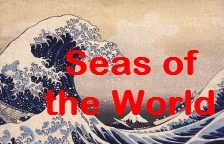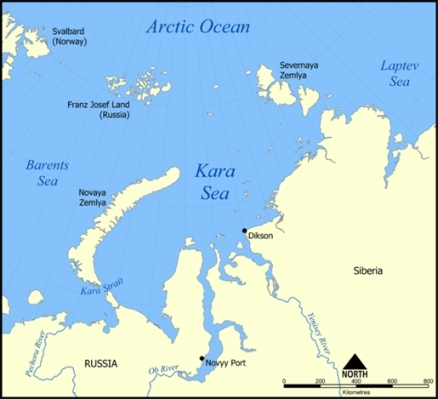Kara Sea
Seas of the World  The Kara Sea (alternatively, Karshoe More) is a saline marine body that is an element of the Arctic Ocean, situated north of the Siberian region of Russia.
The Kara Sea (alternatively, Karshoe More) is a saline marine body that is an element of the Arctic Ocean, situated north of the Siberian region of Russia.
Lying on the Siberian shelf, within the Arctic Circle, this marginal sea is divided from the Barents Sea by the Kara Strait and the large island of Novaya Zemlya at the west. To its east lie the Laptev Sea and the Severnaya Zemlya (Northern Land Islands).
Contents
Geography and hydrography
The Kara Sea is very cold compared to the Barents, which is at a similar latitude to the west. There are numerous islands within the Kara, many of which are situated in the center of the sea, as opposed to simply near coastal islands. The average depth of the Kara Sea is only slightly more than 100 meters. Most of the year finds the Kara Sea totally ice-bound with respect to navigation; such a circumstance impeded exploration of the Kara until modern times, when ice-breaking vessels had achieved a substantial capability.
Radioactive waste disposal
From the mid 1960s until the demise of the Soviet Union, considerable amounts of radioactive wastes were disposed of into the Kara Sea. High level nuclear wastes were routinely disposed of from nuclear powered submarines, in the course of refueling operations. Ina addition, entire reactors that had suffered accidents or malfunctions were discarded into the Kara basin: at least ten electrical power generation nuclear reactors and six nuclear submarine reactors were deposited at the sea bottom.
Non-radioactive marine pollution
Contaminants can be found in regions that are a part of the watershed of the rivers that discharge to the Kara Sea. Some of the rivers are polluted with PCBs, DDT), heavy metals, and viral contaminants. The Ob River, for example, contains plutonium and iodine. Moving upstream toward established nuclear (Nuclear waste management) processing facilities, there are documented levels of radionuclides.
Marine biota
See main article: Kara Sea Large Marine Ecosystem
Due to the presence of ice over the Kara Sea for a substantial portion of the year, this basin is a prime location for Polar bearmarine foraging and seal hunting during the winter months. In the year 1993 the Russian Federation announced the formation of the largest protected nature preserve in Eurasia, by protecting over 4000 square kilometers of islands and coastal waters in the eastern Kara Sea.
References
- C. Michael Hogan. 2008. Polar Bear: Ursus maritimus, Globaltwitcher.com, ed. N. Stromberg
- International Hydrographic Organization. 1953. Limits of Oceans and Seas, 3rd edition
- M.E.Mount, M.K.Sheaffer and D.T.Abbott. 1994. Kara Sea radionuclide inventory from naval reactor disposal. J. Environ. Radioactivity, 25, 11-19.
Citation
C. Michael Hogan (Oct 14, 2013). Kara Sea. ed. Peter Saundry. Encyclopedia of Earth. NCSE. Washington DC. Retrieved from http://editors.eol.org/eoearth/wiki/Kara_Sea
